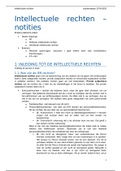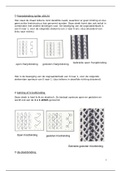Definities
Hoofdstuk 3: Stelsel differentiaalvergelijkingen
Stelling 3.1.1 – Existentie- en éénduidigheidsstelling
Zij A(t) en B(t) continu in interval I en t 0 ∈ I , dan heeft het beginwaardeprobleem
⃗
Y ( t )= A ( t ) ⃗ B (t) en ⃗
Y ( t ) +⃗ Y ( t 0 )=Y⃗0 slechts één oplossing
'
Definitie 3.2.1 – Lineaire onafhankelijkheid
De vectorfuncties ⃗
Y 1 (t) , ⃗
Y 2 ( t ) , … , Y⃗n (t ) zijn lineair onafhankelijk op interval I , indien
n
∑ ci ⃗Y i ( t )= ⃗0 op I , impliceert dat c i=0 ,i=1 , … , n
i=1
Definitie 3.2.2 – Lineaire afhankelijkheid
De vectorfuncties ⃗
Y 1 (t) , ⃗
Y 2 ( t ) , … , Y⃗n (t ) zijn lineair afhankelijk op interval I , indien er constanten c i
n
bestaan, niet alle 0, zodanig dat ∑ ci ⃗Y i ( t )= ⃗0 voor alle t ∈ I
i=1
Definitie 3.2.3 Fundamenteel stel oplossingen
De verzameling vectorfuncties {Y
⃗1 ( t ) , ⃗ Y n (t) } vormt een fundamenteel stel oplossingen voor
Y 2 (t ) , … , ⃗
het homogeen stelsel ⃗
Y ' (t )= A ( t ) ⃗
Y ( t ) op I indien
i. ⃗
Y i ( t )= A ( t ) Y⃗ i ( t ) ,i=1 , … , n
'
ii. ⃗
Y 1 (t) , ⃗
Y 2 ( t ) , … , Y⃗n (t ) lineair onafhankelijk zijn op I
Bewijs: We beschouwen de lineaire afhankelijkheid
De voorwaarde is nodig:
Uit de definitie van lineaire onafhankelijkheid volgt dat er coëfficiënten c i bestaan – niet allen nul
– zodat
n
∑ ci ⃗Y i ( t )= ⃗0
i=1
Vermits dit geldt ∀ t ∈ I :
n
∑ ci ⃗Y i ( t0 ) =⃗0
i=1
Of m.a.w. de vectoren ⃗
Y 1 ( t0 ) , ⃗
Y 2 ( t0 ) , … , ⃗
Y n ( t 0 ) zijn lineair onafhankelijk.
, De voorwaarde is voldoende:
Stel dat er constanten c i – niet allen nul – bestaan zodat:
n
∑ ci ⃗Y i ( t )= ⃗Y ( t )
i=1
Deze vectorfunctie is een oplossing van het homogeen stelsel vermits:
n n
⃗
Y ' ( t ) =∑ c i ⃗
Y ' i ( t )=∑ c i A i ( t ) Y⃗ i ( t )= A ( t ) Y⃗ ( t )
i=1 i=1
Zij voldoet bovendien aan de beginvoorwaarden ⃗ Y ( t 0 )=0⃗ en moet dus volgens de
eenduidigheidsstelling gelijk zijn aan de triviale oplossing. Daarmee is aangetoond dat de
vectorfuncties ⃗
Y 1 (t) , ⃗
Y 2 ( t ) , … , Y⃗n ( t ) voldoen aan de lineaire onafhankelijkheid.
Stelling 3.2.5 – Algemene oplossing van een homogeen stelsel.
Zij {Y
⃗1 ( t ) , ⃗ Y n (t) } een fundamenteel stel oplossingen van ⃗
Y 2 (t) , … , ⃗ Y (t )= A ( t ) ⃗
'
Y ( t ), dan wordt de
algemene oplossing van het homogeen stelsel gegeven door
n
Y ( t )=∑ c i Y⃗ i ( t )
⃗
i=1
met c 1 , c2 , … c n willekeurige constanten.
Stelling 3.3.1 – Algemene oplossing van een niet-homogeen stelsel.
Zij {Y
⃗1 ( t ) , ⃗ Y n (t) } een fundamenteel stel oplossingen van ⃗
Y 2 (t) , … , ⃗ Y ( t ) en ⃗
Y ' (t )= A ( t ) ⃗ Y p ( t ) een
gekende oplossing van ⃗
Y ( t )= A ( t ) ⃗
'
Y ( t ) +⃗
B (t) dan wordt de algemene oplossing van het niet-homogeen
stelsel gegeven door
n
⃗ Y p ( t ) + ∑ ci ⃗
Y ( t )=⃗ Y i(t )
i=1
met c 1 , c2 , … c n willekeurige constanten.
Bewijs: De vectorfunctie ⃗
U ( t )= ⃗
Y ( t ) −⃗
Y p ( t ) voldoet aan het homogeen stelsel immers:
U (t)=⃗
⃗ Y ( t )−⃗
' ' '
Y p (t)
¿ A ( t )∗⃗ Y (t)+⃗ B ( t )− A ( t )∗⃗
Y p ( t )− ⃗
'
B (t )
⃗ ⃗
¿ A ( t ) ( Y ( t ) −Y p ( t ) )
¿ A ( t )∗U ⃗ (t )
n
Uit ⃗
Y ' ( t )= ∑ c i Y⃗ i ( t ) volgt aan onmiddellijk hetzelfde
i=1
,3.3.2 De methode van de variatie van de constanten
We geven nu een algemene methode voor het vinden van een particuliere oplossingen ⃗Y p ( t ). Verwijzend
naar de matrixoplossing Z(t) kan de algemene oplossing van het homogeen stelsel ook geschreven
worden als
[]
c1
⃗ ⃗ c
Y h ( t ) =Z ( t ) ⃗
C met C= 2
…
cn
We zoeken dan een particuliere oplossing van het niet-homogeen stelsel in de vorm
⃗ ⃗ (t)
Y p ( t )=Z ( t ) C
Ingevuld in ⃗
Y ( t )= A ( t ) ⃗
'
Y ( t ) +⃗
B (t ) geeft dit de voorwaarde
⃗
Y p (t )= A ( t ) ⃗
'
Y p ( t ) +⃗
B (t)
' ⃗ ⃗ ' ⃗ (t)+ ⃗
Z ( t ) C ( t ) +Z ( t ) C ( t )= A ( t ) Z ( t ) C B (t )
Rekening houdend met Z' ( t )=A ( t ) Z ( t )
⃗ ' ( t )= ⃗
Z (t )C B (t )
⃗
C ( t )=Z (t) ⃗
' −1
B (t )
t
C ( t )=∫ Z ( ξ ) ⃗
−1
B ( ξ ) dξ
t0
Met t 0 ∈ I . De algemene oplossing van in ⃗
Y ' (t )= A ( t ) ⃗
Y ( t ) +⃗
B (t) wordt dus gegeven door
( )
t
⃗
Y ( t )= ⃗ C +∫ Z ( ξ ) ⃗
Y h ( t ) + Y⃗ p ( t )=Z ( t ) ⃗
−1
B ( ξ ) dξ
t0
Substitueren we hierin de waarde t=t 0, dan bekomen we
⃗
Y ( t 0 )=Z ( t 0 ) ⃗
C of ⃗
C=Z−1 ( t 0 ) ⃗
Y0
De oplossing van het beginwaardeprobleem wordt dus
( )
t
Y ( t )=Z ( t ) Z ( t 0 ) Y⃗ 0+∫ Z ( ξ ) ⃗
⃗ −1 −1
B ( ξ ) dξ
t0
Stelling 3.4.4 Oplossing van het homogeen stelsel
, Beschouw het homogeen stelsel ⃗
Y ' ( t )= A . ⃗
Y ( t ) met A een constante n x n – matrix voor elke
eigenwaarde x met bijhorden eigenvector ⃗
E is ⃗
Y ( t )= ⃗
E . e λt een oplossing.
Bewijs: Uit ⃗
Y ( t )= ⃗
λt
E . e volgt dat
⃗
Y ' ( t )=⃗
E λe
λt
Vermits A ⃗
E =λ ⃗
E geldt dat
⃗
Y ' ( t )=A ⃗
E e λt = A . ⃗
Y (t )
3.4.3 Oplossing van het niet-homogeen stelsel
Ook voor het vinden van een particuliere oplossing van een niet-homogeen stelsel
⃗
Y (t )= A Y⃗ ( t )+ ⃗
'
B (t)
Met A een n × n constante matrix, kunnen we op een efficiënte manier gebruik maken van de
eigenwaarden en eigenvectoren van A . We beschouwen enkel het geval dat A allemaal reële
eigenwaarden en lineair onafhankelijke eigenvectoren heeft. Substitutie van A=P J P−1 in
bovenstaande vergelijking geeft
⃗
Y ' (t )=P J P−1 Y⃗ ( t ) + ⃗
B (t)
P Y ( t )=J P Y ( t ) + P ⃗
⃗ ⃗
−1 ' −1 −1
B (t)
Stellen we dan
⃗
U ( t )=P ⃗
−1
Y (t )
⃗
C ( t )=P ⃗
−1
B (t )
Dan hebben we het oorspronkelijke stelsel teruggebracht tot
⃗ '
⃗ ( t ) +⃗
U ( t ) =J U C( t)
Dit nieuwe stelsel is ontkoppeld in n eerste orde differentiaalvergelijkingen die één na één afzonderlijk
kunnen opgelost worden. Uitgeschreven wordt dit stelsel immers
u'i ( t )=λi ui ( t ) +c i ( t ) , i=1 , … ,n
Met als algemene oplossing
( )
t
K i+∫ e
λ il −λ i l
ui ( t )=e c i ( ξ ) dξ
t0
En K i een constante. Hebben we een beginwaardenprobleem
⃗
Y ( t 0 )=Y⃗0
Dan kunnen deze voorwaarden onmiddellijk in rekening gebracht worden vermits
⃗
U ( t 0 )=P ⃗
−1
Y0
−λ i l
We stellen K i=e ui ( t 0 ) , i=1 , … , n.
Hoofdstuk 3: Stelsel differentiaalvergelijkingen
Stelling 3.1.1 – Existentie- en éénduidigheidsstelling
Zij A(t) en B(t) continu in interval I en t 0 ∈ I , dan heeft het beginwaardeprobleem
⃗
Y ( t )= A ( t ) ⃗ B (t) en ⃗
Y ( t ) +⃗ Y ( t 0 )=Y⃗0 slechts één oplossing
'
Definitie 3.2.1 – Lineaire onafhankelijkheid
De vectorfuncties ⃗
Y 1 (t) , ⃗
Y 2 ( t ) , … , Y⃗n (t ) zijn lineair onafhankelijk op interval I , indien
n
∑ ci ⃗Y i ( t )= ⃗0 op I , impliceert dat c i=0 ,i=1 , … , n
i=1
Definitie 3.2.2 – Lineaire afhankelijkheid
De vectorfuncties ⃗
Y 1 (t) , ⃗
Y 2 ( t ) , … , Y⃗n (t ) zijn lineair afhankelijk op interval I , indien er constanten c i
n
bestaan, niet alle 0, zodanig dat ∑ ci ⃗Y i ( t )= ⃗0 voor alle t ∈ I
i=1
Definitie 3.2.3 Fundamenteel stel oplossingen
De verzameling vectorfuncties {Y
⃗1 ( t ) , ⃗ Y n (t) } vormt een fundamenteel stel oplossingen voor
Y 2 (t ) , … , ⃗
het homogeen stelsel ⃗
Y ' (t )= A ( t ) ⃗
Y ( t ) op I indien
i. ⃗
Y i ( t )= A ( t ) Y⃗ i ( t ) ,i=1 , … , n
'
ii. ⃗
Y 1 (t) , ⃗
Y 2 ( t ) , … , Y⃗n (t ) lineair onafhankelijk zijn op I
Bewijs: We beschouwen de lineaire afhankelijkheid
De voorwaarde is nodig:
Uit de definitie van lineaire onafhankelijkheid volgt dat er coëfficiënten c i bestaan – niet allen nul
– zodat
n
∑ ci ⃗Y i ( t )= ⃗0
i=1
Vermits dit geldt ∀ t ∈ I :
n
∑ ci ⃗Y i ( t0 ) =⃗0
i=1
Of m.a.w. de vectoren ⃗
Y 1 ( t0 ) , ⃗
Y 2 ( t0 ) , … , ⃗
Y n ( t 0 ) zijn lineair onafhankelijk.
, De voorwaarde is voldoende:
Stel dat er constanten c i – niet allen nul – bestaan zodat:
n
∑ ci ⃗Y i ( t )= ⃗Y ( t )
i=1
Deze vectorfunctie is een oplossing van het homogeen stelsel vermits:
n n
⃗
Y ' ( t ) =∑ c i ⃗
Y ' i ( t )=∑ c i A i ( t ) Y⃗ i ( t )= A ( t ) Y⃗ ( t )
i=1 i=1
Zij voldoet bovendien aan de beginvoorwaarden ⃗ Y ( t 0 )=0⃗ en moet dus volgens de
eenduidigheidsstelling gelijk zijn aan de triviale oplossing. Daarmee is aangetoond dat de
vectorfuncties ⃗
Y 1 (t) , ⃗
Y 2 ( t ) , … , Y⃗n ( t ) voldoen aan de lineaire onafhankelijkheid.
Stelling 3.2.5 – Algemene oplossing van een homogeen stelsel.
Zij {Y
⃗1 ( t ) , ⃗ Y n (t) } een fundamenteel stel oplossingen van ⃗
Y 2 (t) , … , ⃗ Y (t )= A ( t ) ⃗
'
Y ( t ), dan wordt de
algemene oplossing van het homogeen stelsel gegeven door
n
Y ( t )=∑ c i Y⃗ i ( t )
⃗
i=1
met c 1 , c2 , … c n willekeurige constanten.
Stelling 3.3.1 – Algemene oplossing van een niet-homogeen stelsel.
Zij {Y
⃗1 ( t ) , ⃗ Y n (t) } een fundamenteel stel oplossingen van ⃗
Y 2 (t) , … , ⃗ Y ( t ) en ⃗
Y ' (t )= A ( t ) ⃗ Y p ( t ) een
gekende oplossing van ⃗
Y ( t )= A ( t ) ⃗
'
Y ( t ) +⃗
B (t) dan wordt de algemene oplossing van het niet-homogeen
stelsel gegeven door
n
⃗ Y p ( t ) + ∑ ci ⃗
Y ( t )=⃗ Y i(t )
i=1
met c 1 , c2 , … c n willekeurige constanten.
Bewijs: De vectorfunctie ⃗
U ( t )= ⃗
Y ( t ) −⃗
Y p ( t ) voldoet aan het homogeen stelsel immers:
U (t)=⃗
⃗ Y ( t )−⃗
' ' '
Y p (t)
¿ A ( t )∗⃗ Y (t)+⃗ B ( t )− A ( t )∗⃗
Y p ( t )− ⃗
'
B (t )
⃗ ⃗
¿ A ( t ) ( Y ( t ) −Y p ( t ) )
¿ A ( t )∗U ⃗ (t )
n
Uit ⃗
Y ' ( t )= ∑ c i Y⃗ i ( t ) volgt aan onmiddellijk hetzelfde
i=1
,3.3.2 De methode van de variatie van de constanten
We geven nu een algemene methode voor het vinden van een particuliere oplossingen ⃗Y p ( t ). Verwijzend
naar de matrixoplossing Z(t) kan de algemene oplossing van het homogeen stelsel ook geschreven
worden als
[]
c1
⃗ ⃗ c
Y h ( t ) =Z ( t ) ⃗
C met C= 2
…
cn
We zoeken dan een particuliere oplossing van het niet-homogeen stelsel in de vorm
⃗ ⃗ (t)
Y p ( t )=Z ( t ) C
Ingevuld in ⃗
Y ( t )= A ( t ) ⃗
'
Y ( t ) +⃗
B (t ) geeft dit de voorwaarde
⃗
Y p (t )= A ( t ) ⃗
'
Y p ( t ) +⃗
B (t)
' ⃗ ⃗ ' ⃗ (t)+ ⃗
Z ( t ) C ( t ) +Z ( t ) C ( t )= A ( t ) Z ( t ) C B (t )
Rekening houdend met Z' ( t )=A ( t ) Z ( t )
⃗ ' ( t )= ⃗
Z (t )C B (t )
⃗
C ( t )=Z (t) ⃗
' −1
B (t )
t
C ( t )=∫ Z ( ξ ) ⃗
−1
B ( ξ ) dξ
t0
Met t 0 ∈ I . De algemene oplossing van in ⃗
Y ' (t )= A ( t ) ⃗
Y ( t ) +⃗
B (t) wordt dus gegeven door
( )
t
⃗
Y ( t )= ⃗ C +∫ Z ( ξ ) ⃗
Y h ( t ) + Y⃗ p ( t )=Z ( t ) ⃗
−1
B ( ξ ) dξ
t0
Substitueren we hierin de waarde t=t 0, dan bekomen we
⃗
Y ( t 0 )=Z ( t 0 ) ⃗
C of ⃗
C=Z−1 ( t 0 ) ⃗
Y0
De oplossing van het beginwaardeprobleem wordt dus
( )
t
Y ( t )=Z ( t ) Z ( t 0 ) Y⃗ 0+∫ Z ( ξ ) ⃗
⃗ −1 −1
B ( ξ ) dξ
t0
Stelling 3.4.4 Oplossing van het homogeen stelsel
, Beschouw het homogeen stelsel ⃗
Y ' ( t )= A . ⃗
Y ( t ) met A een constante n x n – matrix voor elke
eigenwaarde x met bijhorden eigenvector ⃗
E is ⃗
Y ( t )= ⃗
E . e λt een oplossing.
Bewijs: Uit ⃗
Y ( t )= ⃗
λt
E . e volgt dat
⃗
Y ' ( t )=⃗
E λe
λt
Vermits A ⃗
E =λ ⃗
E geldt dat
⃗
Y ' ( t )=A ⃗
E e λt = A . ⃗
Y (t )
3.4.3 Oplossing van het niet-homogeen stelsel
Ook voor het vinden van een particuliere oplossing van een niet-homogeen stelsel
⃗
Y (t )= A Y⃗ ( t )+ ⃗
'
B (t)
Met A een n × n constante matrix, kunnen we op een efficiënte manier gebruik maken van de
eigenwaarden en eigenvectoren van A . We beschouwen enkel het geval dat A allemaal reële
eigenwaarden en lineair onafhankelijke eigenvectoren heeft. Substitutie van A=P J P−1 in
bovenstaande vergelijking geeft
⃗
Y ' (t )=P J P−1 Y⃗ ( t ) + ⃗
B (t)
P Y ( t )=J P Y ( t ) + P ⃗
⃗ ⃗
−1 ' −1 −1
B (t)
Stellen we dan
⃗
U ( t )=P ⃗
−1
Y (t )
⃗
C ( t )=P ⃗
−1
B (t )
Dan hebben we het oorspronkelijke stelsel teruggebracht tot
⃗ '
⃗ ( t ) +⃗
U ( t ) =J U C( t)
Dit nieuwe stelsel is ontkoppeld in n eerste orde differentiaalvergelijkingen die één na één afzonderlijk
kunnen opgelost worden. Uitgeschreven wordt dit stelsel immers
u'i ( t )=λi ui ( t ) +c i ( t ) , i=1 , … ,n
Met als algemene oplossing
( )
t
K i+∫ e
λ il −λ i l
ui ( t )=e c i ( ξ ) dξ
t0
En K i een constante. Hebben we een beginwaardenprobleem
⃗
Y ( t 0 )=Y⃗0
Dan kunnen deze voorwaarden onmiddellijk in rekening gebracht worden vermits
⃗
U ( t 0 )=P ⃗
−1
Y0
−λ i l
We stellen K i=e ui ( t 0 ) , i=1 , … , n.










